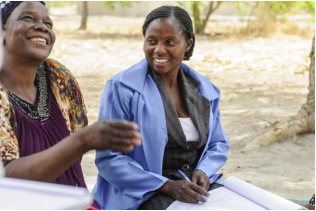By: Nikhil Wilmink, Emily Measures, and Hilda Shakwelele, Katharine Shelley, and Yekoyesew Worku
Zambian Community Health Assistants each provide health promotion and disease prevention to a catchment area of 1,750 residents. Assistants attend a year-long training program whereupon finishing they receive equipment and tools to perform their respective roles. Evidence consistently demonstrates the effectiveness and essential nature of these assistants in supporting Zambian primary health care.
Background
In Zambia, a public sector cadre of salaried Community Health Assistants (CHAs) was created in 2010
through the Ministry of Health (MOH) National Community Health Worker Strategy. This cadre aims to
bring primary health care (PHC) as close to the family as possible, and contribute to the improved
management of malaria, maternal and child health and common preventable health conditions.
Implementation
CHAs are expected to split their time between the Health Post (20%) and community (80%) for household
visits, community education, and health promotion activities. Each CHA is responsible for a catchment size
of 1,750 people. The first cohort of 307 CHAs was trained during 2011–2012 and deployed in late 2012, and
since then the MOH has trained a total of 2,502 CHAs and deployed 1,337 CHAs in 105 of Zambia’s 110
districts.88 An additional 932 CHAs have been deployed with support from cooperating partners, bringing the total number of CHAs deployed to 2,269.
Roles/responsibilities
The main responsibilities of the CHAs are health promotion and disease prevention. CHAs are also trained in
basic curative services that they can provide at the Health Post and in the community. In addition, they are
responsible for identifying patients who need referral. CHAs work alongside other trained staff (typically
nurses or environmental health technologists) at the Health Post and at some PHC Centers. However, due to
Zambia’s human resource constraints, many CHAs work alone at the Health Post or PHC Center and may
receive infrequent supervision. Ideally, CHAs are supposed to be at the Health Post that is closest to the
communities they serve, but due to logistical challenges they can also be found at a PHC Center which is a
level higher than a Health Post.
Training
CHAs attend one year of formalized pre-service training based on 11 training modules covering prevention,
health promotion, and curative care through theoretical and practical training components. Zambia has two
national Community Health Assistant Training Schools with an average certification capacity of 500 CHAs
across both schools per year. CHA Training School tutors hold degrees in nursing and environmental health.
Supervision
CHAs are supervised by a skilled health worker who is the Officer In-charge at the health facility to which
they are linked. Supervision is supposed to be conducted at the health facility and the community level on a
monthly basis using standardized supervisory checklists but is often not carried out because of the pressing
clinical demands of the supervisors.
Incentives and remuneration
CHAs received a salary of 3,735 Zambian Kwacha per month (equivalent to approximately US$ 250 per
month) inclusive of all applicable civil servant benefits. They are also provided with a bicycle, all-weather
work boots, a backpack, and a uniform—all of which are property of the Government of the Republic of
Zambia.
Impact
Evidence from multiple evaluations shows that CHAs have been successfully scaled up into a nationwide
cadre, firmly established in the Zambia health system and recognized for their wide-ranging benefits to PHC.
Read more
Health for the People: National Community Health Worker Programs from Afghanistan to Zimbabwe


Bonjour. Je suis Burundais. Nous n’avons pas acces a vos services.Comment faire?